Matisse’s Stroke in Church Art
Published in: 34. In Worlds and TimesAbout the Author: Anastasia Palamarchuk is a medieval historian, Doctor of Historical Sciences, and a professor at the Russian-Armenian University (Yerevan). Her research interests include the history of Britain in the Middle Ages and early modern period, social history, and church history. She is the author of four scholarly monographs and over a hundred articles. She is also a church organist and a tertiary of the Dominican Order.
What comes to your mind, dear readers, when you hear the phrase “church art”? Certainly, something elevated, costly, and… traditional. Gothic arches of medieval cathedrals, baroque altars, and statues of saints in golden robes, along with colorful paintings depicting biblical scenes. Today, we perceive artworks from the 12th, 15th, and 18th centuries as sacred heritage. It’s worth recalling, though, that gothic architecture was once a novelty, both technically and artistically; that the emotional and passionate expressions typical of baroque art were considered provocative and almost indecent by many contemporaries; and that musical polyphony was viewed as a secularization of church tradition. The emergence of tradition itself is impossible without a quest for creativity.
The work of Henri Matisse (1869-1954) reflects a continual quest for style, form, and visual expression—a desire to convey the vitality of life and the joy of existence through simple yet powerful means. Although the artist was an atheist, he repeatedly showed interest in religious art. In 1911, Matisse visited Moscow and became acquainted with Russian iconography, which was actively being collected and displayed by collectors such as Tretyakov and Ostroukhov. He believed that the simplicity of forms and the richness and intensity of colors in medieval icons surpassed even the frescoes of Fra Angelico, embodying the soul of the Russian people and serving as a source of inspiration for contemporary painters.
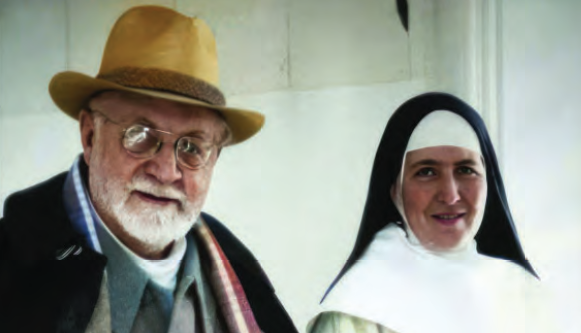
Henri Matisse with Sister Jacques-Marie Bourgeois
The episode we’lll discuss today pertains to a period when Matisse’s creative and personal journey was nearing its end. After the onset of World War II, the seventy-year-old artist, who declined offers to emigrate to the United States or South America, settled in the countryside, spending time in Nice or its suburb, the small town of Vence. He was seriously ill, and in 1942, he placed an advertisement seeking a nurse at a nursing school in Nice. According to the ad, the candidate was required to be not only competent in medical care but also “young and attractive.”
The ad caught the attention of a young nursing student, Monique Bourgeois. Although no one considered her “attractive,” she was hired. Soon, a genuine friendship developed between the nurse and the patient, and Monique even agreed to pose for the artist. Between 1942 and 1943, Matisse painted four portraits of Monique Bourgeois, which she, however, found dreadful.
While Monique was working as Matisse’s nurse and engaging him in discussions about art, she gradually discovered her calling to a consecrated life. She encountered Dominican sisters in Monteils while recovering from the effects of tuberculosis. In 1944, she firmly decided to join the sisters and informed a deeply upset Matisse of her decision. The artist reacted negatively, while Monique attempted to explain her position. Matisse wrote: “I do not need lectures on monastic vocation. I do not need sacraments to glorify God with my life. I traveled all the way to Tahiti to admire the beauty of the world He created and to share it through my work.”
In September 1944, Monique Bourgeois was accepted into the novitiate of the Dominican Sisters in Monteils under the name Sister Jacques-Marie, and on September 8, 1946, she took her monastic vows. According to the congregation’s rules, after taking vows, sisters were not sent back to their native regions; however, Sister Jacques-Marie returned to Vence due to circumstances. At that time, the Dominicans in the town were cramped in an old building, practically a shed, with a leaking roof, and were seeking to build a new monastery — which, of course, would include a chapel. Sister Jacques-Marie created a sketch of the scene depicting the Assumption of the Blessed Virgin Mary and showed it to Matisse. By this time, Matisse had come to accept his former nurse’s decision and convinced the nun that her concept should be realized as a stained-glass window. Over the next few years, Sister Jacques-Marie and Matisse immersed themselves in developing a new architectural project — the Rosary Chapel. Naturally, this project was to be an experiment. It scarcely conformed to the traditional standards of the Catholic Church. Unsurprisingly, the chapel project faced misunderstanding and resistance not only from society but also from the Church, particularly from the abbess of the monastery to which Sister Jacques-Marie belonged. The reputation of Matisse as an exclusively secular figure, a creator of highly provocative works, worked against him in the minds of the faithful at that time.
The realization of the project proposed by Matisse for the Rosary Chapel was largely due to the intervention and consultations of the Dominican brothers, particularly Father Marie-Alain Couturier, who was then the leading order expert in church art. A graduate of the renowned Dominican seminary Le Saulchoir and the Roman university Angelicum, from 1936 to 1954, Father Couturier, along with another Dominican, art historian Pie-Raimond Regamey, co-edited the Paris journal “Sacred Art.” This journal united believers — laypeople and clergy, artists and critics — who sought, in the spirit of general church renewal, to find common ground between contemporary art trends and the life of the Church, and to explore new approaches to church architecture and painting. Father Couturier supported other innovative architectural projects, including the construction of a chapel in Ronchamp designed by Le Corbusier, his Dominican monastery project in La Tourette, and the installation of stained-glass windows by Auguste Perret, Marc Chagall, and Fernand Léger in French churches. Father Couturier maintained personal friendships with many artists worldwide, and he also developed a warm relationship with Matisse. It is commonly believed that he served as the model for the figure of St. Dominic that adorns the wall of the chapel in Vence.
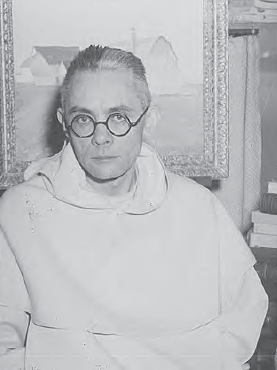
Father Alain Couturier
Matisse’s personal friendships with these two artistically gifted Dominicans, a sister and a brother, likely helped him, despite his distance from church and monastic life, to engage with the Dominican tradition of communal prayer, iconography, contemplation, and preaching. According to the teachings of the Order’s founder, St. Dominic de Guzmán, these practices should be accessible to all and expressed through various means, including artistic imagery. The monastic pursuit of spiritual perfection resonated with Matisse’s quest for excellence and simplicity in visual forms. Moreover, the praying sisters in their black-and-white habits were destined to become part of his artistic vision; Matisse also created a set of vestments for the liturgy throughout the liturgical year specifically for the Rosary Chapel. Art was intended to inspire the prayers of the community, and the community itself became part of the artwork. Matisse wrote in a letter to Bishop Raymond of Nice: “I began with the profane; at the sunset of my life, I naturally conclude with the divine.”

In 1949, the Bishop of Nice blessed the cornerstone of the future chapel. In 1951, he consecrated the completed building. The event was the subject of a separate article in Father Couturier’s journal “Sacred Art,” which included photographs of the chapel, sketches, and comments that Matisse provided in a letter to Bishop Raymond.
The interior of the chapel is bright and airy, maximally uncluttered, adorned with a series of vertical stained-glass windows in shades of blue and gold — the traditional colors of the Virgin Mary and simultaneously the colors of royal Catholic France. The repetition and rhythm of the stained glass correspond to the rhythm of the Rosary prayer, based on the repetition of the “Hail Mary.” The light that streams through the stained glass symbolizes the light of the mysteries of the Rosary contemplated by the sisters (the Biblical events recalled during the Rosary service).
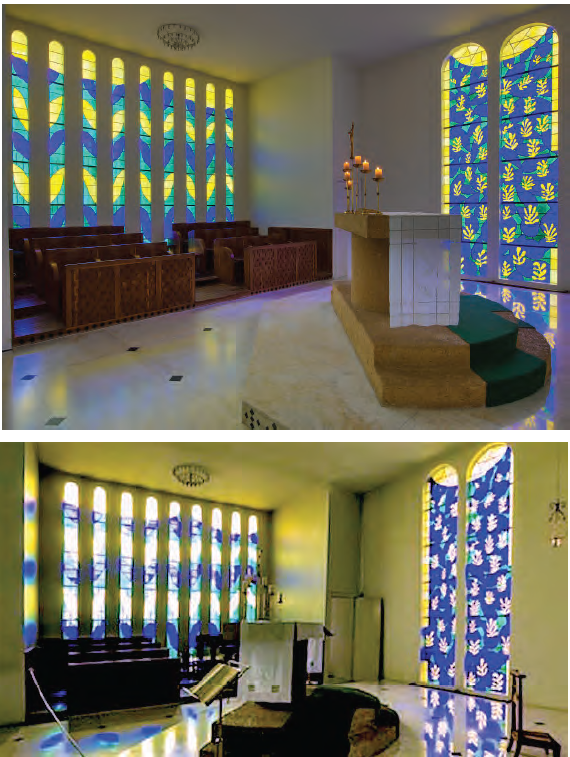
The focal point of the presbytery (the space where the altar is positioned and where the clergy stands during the liturgy) is a visual representation of the figure of St. Dominic, conforming to all traditional canons for depicting the saint and founder of the Dominicans. St. Dominic appears to us in full habit — tunic, scapular, and cloak, holding a book. The benches designated for the sisters of the monastery were placed directly opposite the image of St. Dominic. Since his image lacks distinct facial features, each sister called to continue the founder’s work and mission could see herself, or a brother or a sister, in him, and reflect on her place in the service of the Order. The outlined form of St. Dominic helped convey a crucial aspect of the Dominican — and, more broadly, Christian — worldview: freedom.
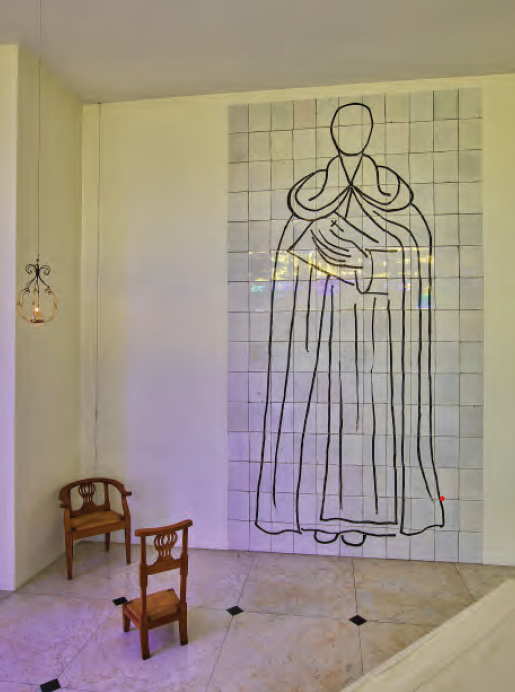
The wall of the chapel, along which the pews for laypeople were arranged, is adorned with an image of the Virgin Mary with the Infant Jesus. Just like the image of St. Dominic, the portrayal of the Blessed Virgin conforms to the iconographic canon; it is recognizable and, in a certain sense, traditional. Yet again, we see only an outline, a universal form that grants freedom for contemplative prayer. Unlike traditional church painting, this image does not impose a specific mood or idea on the worshipper through colors and facial expressions. Each person praying could “fill” this outline with the requests, gratitude, and emotions they addressed to the Mother of God, fostering a personal and unique relationship with the Mother of the Savior.
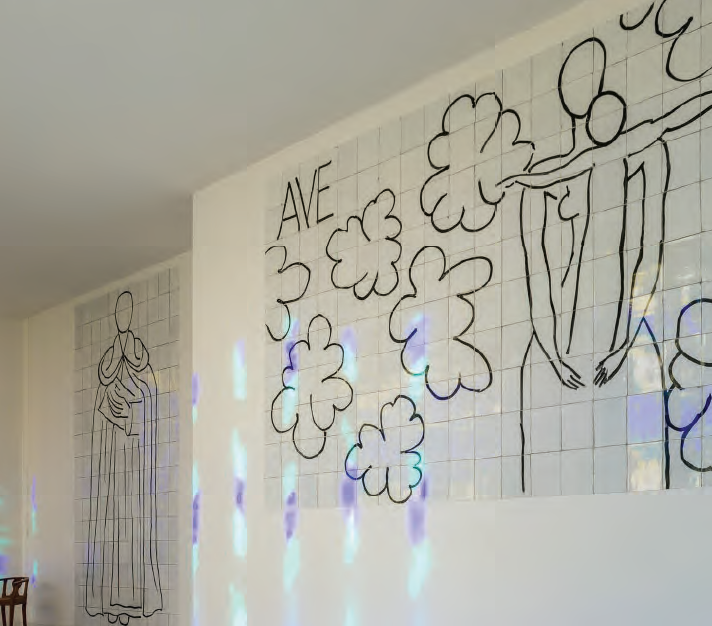
Finally, on the back wall behind the worshippers were images of the Stations of the Cross. Traditionally, images of the so-called “stations,” that is, the stops of Jesus on the day of his journey to Golgotha, are placed on the side walls of a church or chapel. Matisse chose to concentrate all the dramatic narrative on one wall. Among all the images in the chapel, the fourteen Stations of the Cross are perhaps the most provocative, barely hinting at church tradition. However, as Matisse himself said, “Exactness is not truth.” Contemplation is not merely about scrutinizing details in a painting. Contemplative prayer aims to perceive the essence of God and, to some extent, transcend the images we see with our earthly eyes and hold in our memory. It is this transcendence of created reality that Matisse’s outlined “stations” facilitate: contemplative prayer becomes what it should be — a spiritual effort directed toward God.
To reveal Himself to humanity, the Lord often employs the most unexpected means. What happens when we combine the talent of an artist distant from the church, the experience of an intellectual brother, and the inspiration of a former nurse? We get the Rosary Chapel in Vence, an extraordinary, provocative and bold invitation to prayer, a call to take a step beyond the ordinary in personal spiritual life.
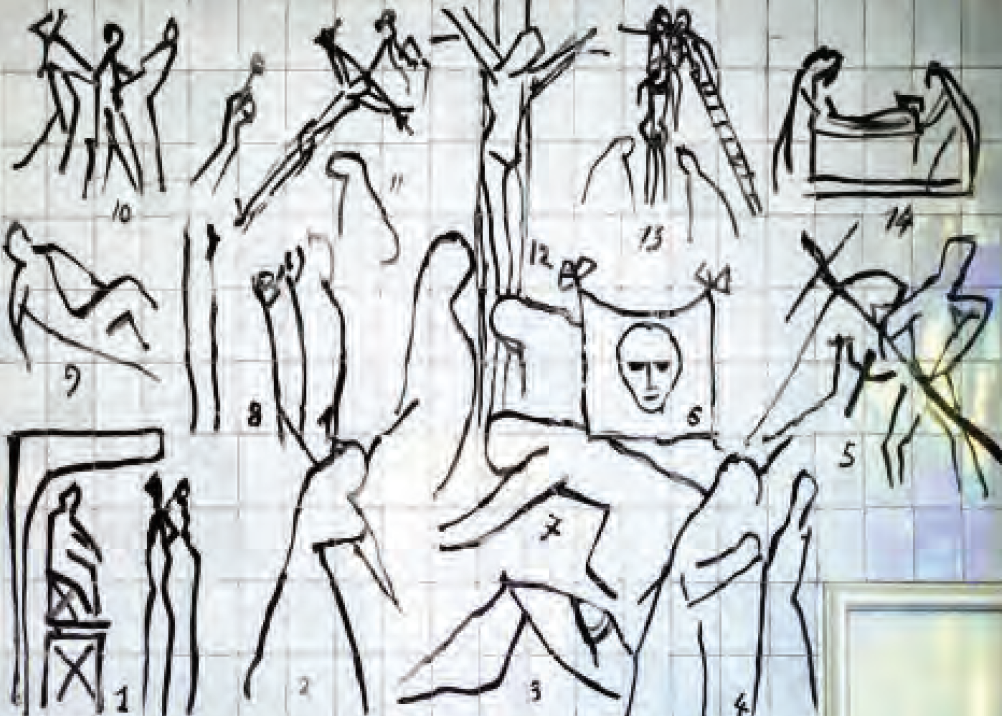


Speak Your Mind